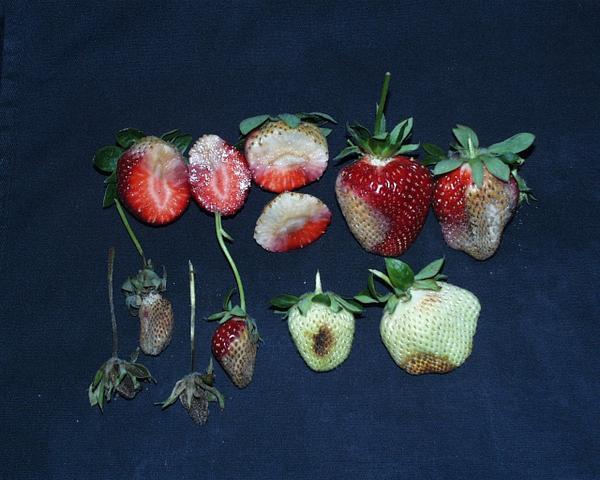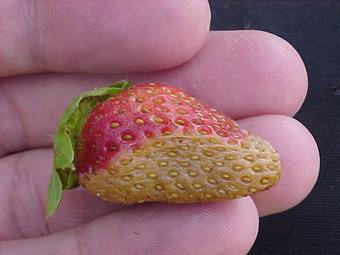Introduction
Leather rot, caused by Phytophthora cactorum, may cause substantial losses of fruit yield in wet years, and is particularly troublesome for pick-your-own operations, where undetected diseased fruit mixed in with healthy fruit may result in bitter tasting jams and jellies. Leather rot has been recorded only sporadically in plasticulture systems and is more likely to occur in matted row systems. Phytophthora spp. may also cause crown rot of strawberry, although these two diseases do not necessarily occur together.
Symptoms and Signs
Phytophthora cactorum may infect fruit at any stage of development (Figure SS-1). On green fruit, diseased areas remain firm (Figure SS-2). The green color may remain with brown margins around infected areas, but eventually the entire fruit becomes brown with a rough and leathery texture. Infected mature fruit have a bitter, unpleasant taste and odor even though there may be little change in color. Sometimes the berry has a brown to dark purple hue, and when sectioned, the vascular tissue to each seed is darkened. Under conditions of high humidity, white mycelia can grow on the surface of the fruit. Eventually, infected green and mature fruit become dry, shrivel, and mummify (Figure SS-2). Mycelial growth can be encouraged in the laboratory by placing the berries in a moist chamber at room temperature and incubating for one to two days. The main symptom that could be confused with leather rot is sun scald. However, fruit tend to be more tan with sunscald, damaged on the exposed side of the fruit (e.g. towards the sun or sitting on black plastic) and will not have the diagnostic mycelial growth during incubation (Figure SS-3).
Disease Cycle
Phytophthora cactorum overwinters as oospores in mummified fruit or soil. Oospores germinate in the spring in saturated soil producing sporangia with zoospores. Sporangia, zoospores, and mycelial fragments may then be splash dispersed to healthy fruit by rain, overhead irrigation water, or by the downward flow of water between rows. Moist conditions with temperatures between 17-25°C (21°C optimal; 63 to 77°F) are needed for zoospore infection. After fruit infection, further sporangia formation can occur within 5 days if temperatures are between 15 and 25°C with an optimum temperature of 20°C. Disease incidence can explode in a few days if conditions remain favorable. Oospores can form in infected fruit tissues that may eventually dry up, mummify, and fall into the soil where they can disintegrate and provide an inoculum source for long periods of time. The pathogen is easily spread with movement of contaminated water.
Management
Cultural
1. Site Selection and Preparation
Select a planting site that is well drained with good sun exposure. To further reduce excess moisture, use raised beds and proper row orientation to facilitate drainage. Do not allow soil to compact or develop ruts as this will encourage water puddling. Practice proper plant spacing and weed control to promote airflow for quick drying of plant surfaces. These tactics help to reduce disease pressure by making conditions unfavorable for oospore germination and zoospore motility. The disease is most likely to occur in low lying areas where free water persists. Leather rot has only been observed as a problem one time since 1997 in North Carolina. This was associated with overhead irrigation of water from a pond that drained from an ornamental plant nursery. P. cactorum is a pathogen on ornamental plants and the pathogen was carried with water and transmitted to strawberries during overhead watering events for frost protection.
2. Mulches
Use mulches such as straw or plastic mulch, to help reduce contact between fruit and soil, to provide a barrier between the plant and standing water, and to reduce rain splash. Be aware that plastic mulch may allow water to collect and actually increase the amount of water splash.
Chemical Control
During wet years, fungicides are often necessary in matted row systems; rarely in plasticulture systems. Mefenoxam, (Ridomil formulations), metalaxyl (various name brands) and the phosphonate chemistries (various name brands) are highly effective systematic fungicides registered for control of leather rot. The QoI fungicides have also proven effective. Current fungicide recommendations and efficacy ratings are available at the Southern Region Small Fruit Consortium.
Pathogen
Phytophthora cactorum (Lebert and Cohn) J. Schröt. is a soil inhabiting Oomycete plant pathogen. Unlike true fungi, Oomycetes have cell walls made of cellulose instead of chitin, lack septa within their hyphae (coenocytic), and are diploid in their vegetative state (Erwin and Ribeiro, 1996). Oospores of P. cactorum are spherical (24-30 µm), have a smooth, two layered wall, and are produced after the fusion of an antheridium and oogonium. Antheridia typically are paragynous and usually attached to the oogonium near the oogonial stalk. P. cactorum produces caducous, pear-shaped sporangia (50-60 x 35-40 µm), each on a short (< 4 μm) pedicel. Sporangia usually are terminal and have prominent papillae (Ellis and Madden, 1998; Erwin and Ribeiro, 1996). P. cactorum is a homothallic species, meaning oospores can be found within single isolate cultures (Erwin and Ribeiro, 1996; Hudler, 2013).
Diagnostic Procedures
P. cactorum can be baited from soil and isolated from the root or stem tissue of infected plants using selective media. Most often P. cactorum is isolated using PPP or PARP and cultured on CMA or V8A. If baiting soil for P. cactorum it is important to dry soil samples for a time and then rehydrate them prior to baiting (Jeffers and Aldwinckle, 1987).
A distinctive characteristic of this pathogen compared to other Phytophthora species is the caducous nature of the sporangia. Most isolates of P. cactorum readily fruit on plant tissue and in culture, however, if sporangia are absent, formation can be induced by immersing agar plugs from an actively growing culture in 1.5% non-sterile soil extract solution (NSSES) and incubating at room temperature under constant fluorescent light for 12-24 hours (Jeffers and Aldwinckle, 1987).
Serology kits (Immunostrips etc.) are available from several companies and provide a rapid test for the genus Phytophthora. The most conclusive means of identifying an isolate of Phytophthora is through molecular techniques. The ITS 1 and 2 regions of the rDNA and the cox 1 and 2 regions of mitochondrial DNA can be amplified using PCR, purified, and then sequenced. Sequences can then be compared to those of verified Phytophthora species recorded in databases like Phytophthora db and genbank.
References
Ellis, M. A., and Madden, L. V. 1998. Leather rot. Pp. 33-35 in: Compendium of Strawberry Diseases, 2nd edition, Maas, J. L. (edt.). APS Press. St. Paul, MN.
Erwin, D. C., and Ribeiro, O. K. 1996. Phytophthora Diseases Worldwide. American Phytopathological Society, St. Paul, MN.
Hudler, G. W. 2013. Phytophthora cactorum. Forest Phytophthoras 3(1). doi:10.5399/osu/fp.3.1.3396
Jeffers, S. N., and Aldwinckle, H. S. 1987. Enhancing detection of Phytophthora cactorum in naturally infested soil. Phytopathology 77:1475-1482.
Publication date: July 24, 2014
Reviewed/Revised: July 26, 2024
There is an alternate Spanish language version of this document here: Pudrición de cuero de la fresa
N.C. Cooperative Extension prohibits discrimination and harassment regardless of age, color, disability, family and marital status, gender identity, national origin, political beliefs, race, religion, sex (including pregnancy), sexual orientation and veteran status.



